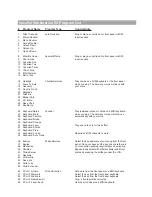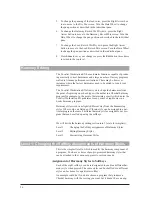
Programs based on Scalic harmony have a selection of different scales you
can choose from by pressing the softkeys. For example, the ÒEverlysÓ pro-
gram (#36) has 3 different major scales and two minors as do many of the
other Scalic-based programs. The major scales differ only on the harmony
note generated on the fifth note of the scale i.e. Maj1 generates a major
chord, Maj2 generates a suspended chord and the Maj3 generates a minor
chord. The two minor scales differ in that they generate a major chord on
the
fourth
note (Min1) or a minor chord (Min2). This may seem a bit con-
fusing so rely on your ears to make the appropriate choices.
Use:
Scalic harmonies are more active in harmony motion where Chordal
tends to be less so. Scalic programs sound the most natural for popular
song harmony.
For examples
of Scalic harmony, choose any of Factory Programs 36
through 45, choose the key on the front panel keyboard and sing. Notice
that as you sing up and down the melody, the Harmony voices stay very
close to you.
Style naming conventions:
The first 3 to 4 characters of the name show
the scale type such as Maj
or
, Min
or
, Dori
ian
etc. The next 3 to 5 charac-
ters show the voicing. For example: Òv3355Ó as found in the Eagles pro-
gram shows that your lead voice (v) has doubled 3rd and doubled 5th har-
monies above it. Numbers to the right show harmonies above and numbers
to the left show harmony voices below.
You may also see two additional characters ÒsmÓ and ÒstÓ. This displays
the setting of the Bending parameter, which determines whether the har-
mony voices will follow the lead vocal sliding smoothly between notes
(sm) or whether the harmony will not slide between notes but will jump
from scale note to scale note in a stepped fashion (st).
For more information on Chordal and Scalic harmony, see the Basic
Harmony Concepts chapter.
Vocoder
Vocoder mode is named after a completely different technology that func-
tions in a similar way. It is not the familiar Òrobot voiceÓ sound. The
Vocalist Workstation EXÕs Vocoder mode does not feature intelligent har-
mony because you play the notes from a MIDI keyboard or the front panel
keyboard that you want to hear as harmonies. Vocoder mode is probably
the most flexible mode allowing you to weave intricate melody lines from
your MIDI keyboard that can be recorded and edited in a MIDI sequencer
like any other MIDI performance.
Use:
Vocoder is for situations where neither a straight chord nor a parallel
harmony line will do. Since you directly control the notes being Òsung",
you can create counter-melodies and harmonies that go in different direc-
tions. While it is more efficient to use a MIDI keyboard in Vocoder pro-
grams, the front panel keyboard is active in these programs as well.
For examples
of Vocoder harmony, try Factory Programs 26 through 35.
Hold down any chord up to four notes on the front panel keyboard or a
MIDI keyboard and sing. Keep in mind that no sound will come out unless
you are holding down some keys. Change the chord, and the Harmony
voices change. You don't even have to singÑpull the Lead Level control
all the way down, and talk into the mic as you play different notes on the
keyboard.
Note:
Scalic har-
mony programs
that generate a
single 3rd interval
generally work for
more songs than
programs with a
combined 3rd and
5th.
15
Содержание VOCALIST Workstation EX
Страница 1: ...VERSION EX 1 2...
















































